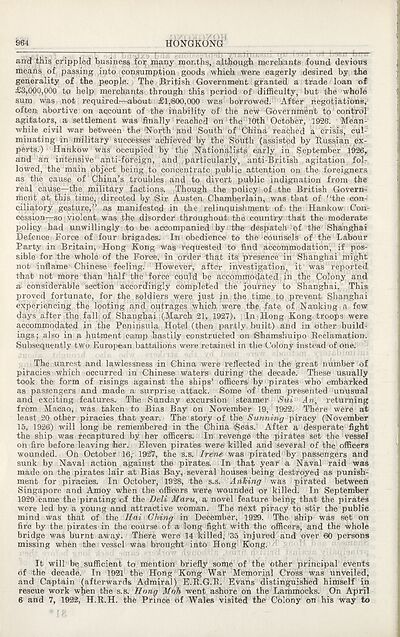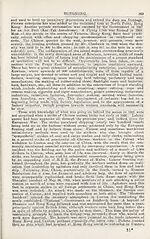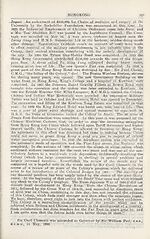1933
(1064) Page 964
Download files
Complete book:
Individual page:
Thumbnail gallery: Grid view | List view

964 hongko^g! 1
and this crippled business for many months, although merchants found devious
means of passing into consumption goods which were eagerly desired by the
generality of the people. The British Government granted a trade loan of
£3,000,000 to help merchants through this period of difficulty, but the whole
sum whs not required—about £1,000,000 was borrowed. After negotiations,
often abortive on aqcount of the inability of the new Government to control
agitators, a settlement was finally reached on the 10th October, 1926. Mean¬
while civil war between the North and South of Ohina reached a crisis, cul¬
minating in military successes achieved by the South (assisted by Russian ex¬
perts.1) Hankow was occupied by the Nationalists early in September 1926,
and an intensive' anti-foreign, and particularly, anti-British, agitation fol¬
lowed, the main object being to concentrate public attention on the foreigners
as the cause of China’s troubles and to divert public indignation from the
real cause—the military factions. Though the policyof . the British Govern¬
ment; at this time, directed by iSir Austen Chamberlain, was that of “the con¬
ciliatory gesture,” as manifested in the relinquishment of the Hankow Con¬
cession—so violent was the disorder throughout the country that the moderate
policy had unwillingly to be accompanied by the despatch of the Shanghai
Defence Force of four brigades. In obedience to the counsels of the Labour
Party in Britain, Hong Kong was requested to find accommodation, if pos¬
sible for .the whole of the Force, in order that its presence in Shanghai might
not inflame Chinese feeling. However, after investigation, it was reported
that not more than half: the force could be accommodated in the Colony and
a considerable section accordingly completed the journey to Shanghai. This
proved fortunate, for the soldiers were just in; the, tinie to prevent Shanghai
experiencing the looting and outrages which were the, fate pf Nanking a few
days after the fall of Shanghai (March 21, 1927). In Hong Kong troops were
accommodated in the Peninsula Hotel (then partly built) and in other build¬
ings; also in a hutment .camp hastily constructed on iShamshuipo Reclamation.
Subsequently two European battalions were retained in the-Colony instead of one.
The unrest and lawlessness in China were reflected in the great number of
piracies which occurred in Chinese waters during the decade. These usually
took the form of risings against the ships’ officers by pirates who embarked
as passengers and made a surprise attack. Some of them presented unusual
and exciting features. The Sunday excursion steamer Sui An, returning
from Macao, was taken to Bias Bay on November 19, 1922. There were at
least 20 other piracies that year. The story of the Sunning -piracy (November
15, 1926) will long be remembered in the China i&eas. After a desperate fight
the ship was recaptured by her officers. In revenge the pirates set the vessel
on fire before leaving her. Eleven pirates were killed and several of the officers
wounded. On October 16, 1927, the s.s. Irene, was pirated by passengers and
sunk by Naval action against the pirates. In that year a Naval raid was
made on the pirates lair at Bias Bay, several houses being destroyed as punish¬
ment for piracies. In October, 1928, the s.s. Anking was pirated between
Singapore and Amoy when the officers were wounded or killed. In September
1929 came the pirating of the Deli Maru, a novel feature being that the pirates
were led by a young and attractive woman. The next piracy to stir the public
mind was that of the Hai Chinq in December, 1929. The ship was set on
fire by the pirates in the course of a long fight with the officers, and the whole
bridge was burnt away. There were 14 killed''35 injured and over 60 persons
missing when the vessel was brought into Hong Kong.
It will be. sufficient to mention briefly sonje of the other principal events
of the decade. In 1921 the Hong Kong War Memorial Cross was unveiled,
and Captain (afterwards Admiral) E.R.G.R. Evans distinguished himself in
rescue work when the s.s. Hong Moh went ashore on the Lammocks. On April
6 and 7, 1922, H.R.H. the Prince of Wales visited the Colony on his way to
and this crippled business for many months, although merchants found devious
means of passing into consumption goods which were eagerly desired by the
generality of the people. The British Government granted a trade loan of
£3,000,000 to help merchants through this period of difficulty, but the whole
sum whs not required—about £1,000,000 was borrowed. After negotiations,
often abortive on aqcount of the inability of the new Government to control
agitators, a settlement was finally reached on the 10th October, 1926. Mean¬
while civil war between the North and South of Ohina reached a crisis, cul¬
minating in military successes achieved by the South (assisted by Russian ex¬
perts.1) Hankow was occupied by the Nationalists early in September 1926,
and an intensive' anti-foreign, and particularly, anti-British, agitation fol¬
lowed, the main object being to concentrate public attention on the foreigners
as the cause of China’s troubles and to divert public indignation from the
real cause—the military factions. Though the policyof . the British Govern¬
ment; at this time, directed by iSir Austen Chamberlain, was that of “the con¬
ciliatory gesture,” as manifested in the relinquishment of the Hankow Con¬
cession—so violent was the disorder throughout the country that the moderate
policy had unwillingly to be accompanied by the despatch of the Shanghai
Defence Force of four brigades. In obedience to the counsels of the Labour
Party in Britain, Hong Kong was requested to find accommodation, if pos¬
sible for .the whole of the Force, in order that its presence in Shanghai might
not inflame Chinese feeling. However, after investigation, it was reported
that not more than half: the force could be accommodated in the Colony and
a considerable section accordingly completed the journey to Shanghai. This
proved fortunate, for the soldiers were just in; the, tinie to prevent Shanghai
experiencing the looting and outrages which were the, fate pf Nanking a few
days after the fall of Shanghai (March 21, 1927). In Hong Kong troops were
accommodated in the Peninsula Hotel (then partly built) and in other build¬
ings; also in a hutment .camp hastily constructed on iShamshuipo Reclamation.
Subsequently two European battalions were retained in the-Colony instead of one.
The unrest and lawlessness in China were reflected in the great number of
piracies which occurred in Chinese waters during the decade. These usually
took the form of risings against the ships’ officers by pirates who embarked
as passengers and made a surprise attack. Some of them presented unusual
and exciting features. The Sunday excursion steamer Sui An, returning
from Macao, was taken to Bias Bay on November 19, 1922. There were at
least 20 other piracies that year. The story of the Sunning -piracy (November
15, 1926) will long be remembered in the China i&eas. After a desperate fight
the ship was recaptured by her officers. In revenge the pirates set the vessel
on fire before leaving her. Eleven pirates were killed and several of the officers
wounded. On October 16, 1927, the s.s. Irene, was pirated by passengers and
sunk by Naval action against the pirates. In that year a Naval raid was
made on the pirates lair at Bias Bay, several houses being destroyed as punish¬
ment for piracies. In October, 1928, the s.s. Anking was pirated between
Singapore and Amoy when the officers were wounded or killed. In September
1929 came the pirating of the Deli Maru, a novel feature being that the pirates
were led by a young and attractive woman. The next piracy to stir the public
mind was that of the Hai Chinq in December, 1929. The ship was set on
fire by the pirates in the course of a long fight with the officers, and the whole
bridge was burnt away. There were 14 killed''35 injured and over 60 persons
missing when the vessel was brought into Hong Kong.
It will be. sufficient to mention briefly sonje of the other principal events
of the decade. In 1921 the Hong Kong War Memorial Cross was unveiled,
and Captain (afterwards Admiral) E.R.G.R. Evans distinguished himself in
rescue work when the s.s. Hong Moh went ashore on the Lammocks. On April
6 and 7, 1922, H.R.H. the Prince of Wales visited the Colony on his way to
Set display mode to:
![]() Universal Viewer |
Universal Viewer | ![]() Mirador |
Large image | Transcription
Mirador |
Large image | Transcription
Images and transcriptions on this page, including medium image downloads, may be used under the Creative Commons Attribution 4.0 International Licence unless otherwise stated. ![]()
| Asian directories and chronicles > 1933 > (1064) Page 964 |
|---|
| Permanent URL | https://digital.nls.uk/203688143 |
|---|
| Attribution and copyright: |
|
|---|---|
| Description | Volumes from the Asian 'Directory and Chronicle' series covering 1917-1941, but missing 1919 and 1923. Compiled annually from a multiplicity of local sources and research. They provide listings of each country's active corporations, foreign residents and government agencies of all nationalities for that year, together with their addresses. Content includes: various treaties; coverage of conflicts; currencies and taxes; consular fees; weights and measures; public holidays; festivals and traditions. A source of information for both Western states and communities of foreigners living in Asia. Published by Hongkong Daily Press. |
|---|---|
| Shelfmark | H3.86.1303 |
| Additional NLS resources: |

